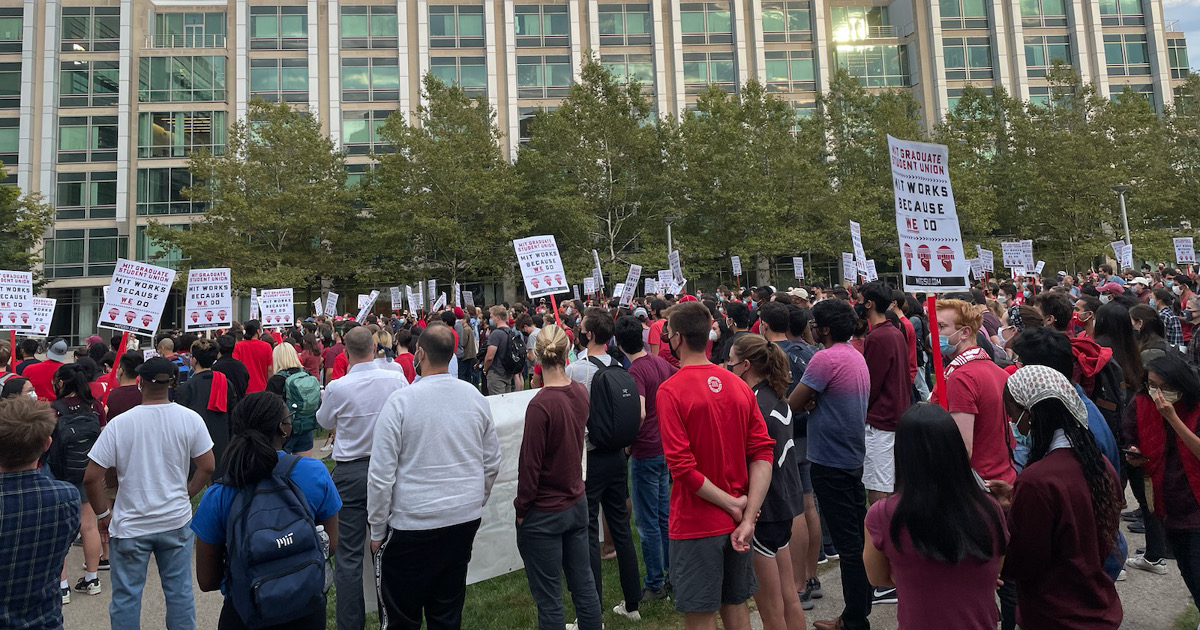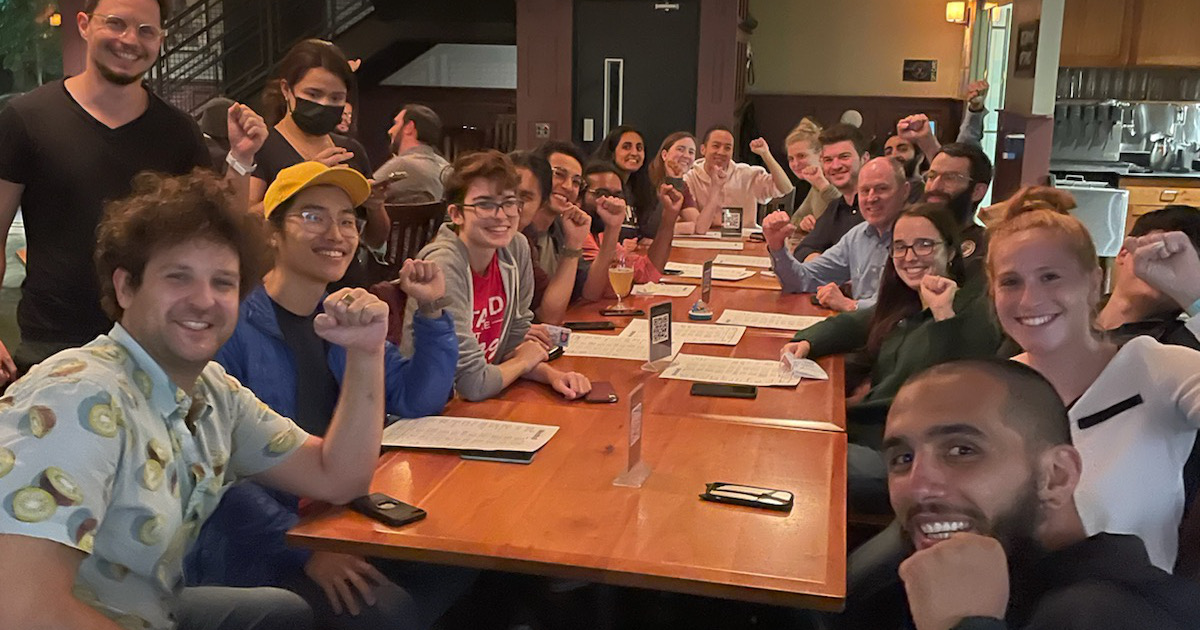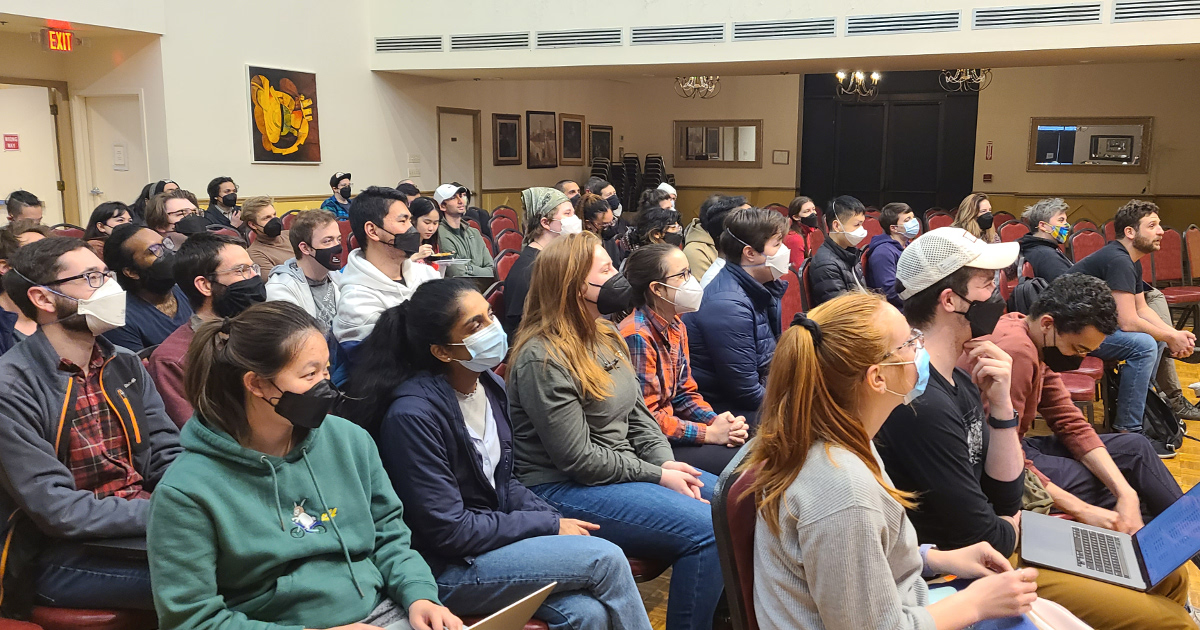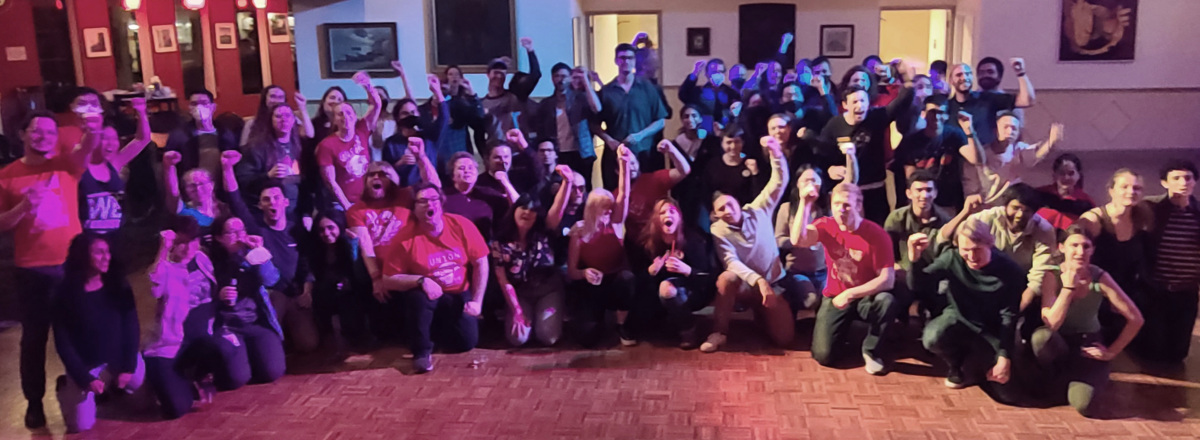In one of the largest NLRB election wins for any union in recent years, 3800 graduate workers at the Massachusetts Institute of Technology voted on April 4 and 5 to join UE. The MIT Graduate Student Union/UE (MIT-GSU) prevailed by a margin of almost two to one. Following the decisive 1785-912 victory, the MIT administration indicated their intention to begin bargaining with the union in an email to all graduate students.
The victory came after many years of a worker-led campaign that exhibited many core UE principles: rank and file control, uniting all workers, and aggressive struggle to improve conditions.
Speaking to the UE Eastern Region council meeting later in April, MIT-GSU member Thejas Wesley told delegates, “We couldn’t have asked for a better national union to partner with.” Director of Organization Mark Meinster added that MIT-GSU will be “an incredible, militant, democratic UE local.”
“We all deserve to have dignity”
MIT grad workers began talking about organizing a union in 2018, holding small meetings in classrooms to discuss the issues that they faced as workers in one of the most prestigious research institutions in the world. Those issues included having to spend over half of their income in rent, harassment, and inadequate access to medical care. Protections for international students, who are especially vulnerable as their visas are tied to their jobs, was also a key issue. International students make up 42 percent of MIT’s graduate student population
Ki-Jana Carter, who attended some of the early meetings, told the UE NEWS that “People felt a real sense of empowerment by hearing for the first time a group of co-workers … express that we all deserve to have dignity.”
Those initial organizing committee meetings had “a really positive energy,” said Carter, and focused on the nuts and bolts of organizing. Grad workers would go through the basics of having an organizing conversation, then practice those skills. They mapped various departments and made plans to reach out in those areas that weren’t yet represented. Organizers would report back to the group about the people they had talked to, and strategize together how to have more effective organizing conversations. It was “a lot of just learning,” said Carter, “understanding how to have an organizing conversation, how to talk to co-workers.”
Campaigns for Mental Health, Racial Justice Build the Union
In 2018 and 2019, the organizing committee launched a “Grad Students for a Healthy MIT” campaign to push MIT to do more to support grad workers’ mental health. The mental health crisis on campus was an “enormous problem” according to Carter, with 70 percent of grad workers reporting having experienced severe depression and anxiety as a result of their workload. As Carter said, while “It's one thing for [graduate school] to be hard because it's intellectually difficult work,” the stress of dealing with harassment or not being able to afford rent was another thing entirely.
Grad Students for a Healthy MIT gave grad workers experience with collective struggle to improve their conditions. It was “a great way to make contact with grad workers who weren’t already in our network,” explained Carter.
The campaign was a success, winning a more than fourfold increase in the number of therapy appointments covered by graduate student health insurance, from 12 to 52, and also winning an expansion of healthcare benefits to be more inclusive of transgender students.
By late 2019, the organizing committee had 30 core members who met weekly, and they had talked with 650 workers about unionization. Around this time they began looking into affiliating with a national union. Carter told the UE NEWS, “the rank-and-file model was very appealing to folks,” because MIT-GSU members had a lot of “pride in what we had managed to build already.” UE’s emphasis on aggressive struggle also spoke to the lessons they had learned in their successful mental health campaign.
MIT-GSU held an affiliation vote, which 250 workers participated in, and overwhelmingly chose to join UE. MIT-GSU leaders who attended the November meeting of UE’s Northeast Region told delegates, “We’re just really excited to be here and to have affiliated with UE,” citing UE’s commitment to rank-and-file democracy and history of opposing war and militarism.
In the summer of 2020, as protests for racial justice swept the country in the wake of the murder of George Floyd by Minneapolis police, MIT-GSU worked with the Black Graduate Student Association and the Graduate Student Council to launch a second campaign, Reject Injustice through Student Empowerment (RISE). RISE linked the racial discrimination and sexual harassment faced by many graduate students to their lack of power. As Carter explained, if your manager is racist or sexist, “there is really nothing you can do about it alone.”
While the campaign was able to win some improvements — most notably, winning guarantees for transitional funding for graduate students who needed to switch labs because of issues with their supervisors — it became clear that winning real and lasting change would only come through collective bargaining.
In the fall 2021, having built an organizing committee of over 200 grad workers with representatives in every department, MIT-GSU publicly announced their intention to pursue unionization with a rally in late September. Hundreds of workers and allies gathered to hear graduate workers speak publicly about the need for a union at MIT, and to launch a membership drive. Over 1,000 grad workers signed UE authorization cards on that first day.

MIT-GSU/UE launch rally, September 2021.
“I didn't really think I had the power to change my situation”
MIT-GSU activists spent the rest of the fall semester reaching out to graduate workers to encourage them to join the union. They walked into labs, made phone calls, and knocked on doors. Many of those visits took place in the graduate student dormitories that house approximately 40 percent of MIT graduate workers — for whom MIT is both their employer and their landlord.
One of those grad workers was Belinda Zou Li, who lives in one of the most expensive graduate student dorms on campus.
“Rent was around 60 to 70 percent of my total stipend,” she told the UE NEWS. “I definitely try to save wherever I can, but there's always that feeling of guilt. Even buying necessities like food or stuff for research makes me feel super guilty.” At times, Li would even ration her meals.
A particular irony for Li is the fact that the dorm she lives in sits on the site of what had been a cheaper option, before MIT demolished it to make way for a more expensive building.
Before getting involved in the union, “I didn't really think I had the power to change my situation,” Li said. After MIT-GSU activists visited her, “I realized that housing is one of the central issues of the union” and that by “organizing together we have way more power to change our situation.”
“A union is the way we make a meaningful and material change”

MIT-GSU members meeting with UE General President Carl Rosen, October 2021.
On December 13, MIT-GSU submitted a letter to MIT President Rafael Reif announcing that an overwhelming majority of MIT’s 5,000 graduate employees had signed union authorization cards and asking for voluntary recognition.
MIT-GSU member Lucy Hu told the Boston Globe that that the fact that a majority of grad workers had signed UE cards was “a reflection of the democratic power that we as graduate students have built. People have joined this movement for a variety of reasons but they all relate to deeply felt systemic issues that MIT has failed to make any movement on. A union is the way we make a meaningful and material change.”
The MIT administration declined to recognize the union, forcing MIT-GSU to file for a National Labor Relations Board election. The administration also insisted that 900 “fellows,” who are funded from a different pot of money than other research assistants, be excluded from the bargaining unit.
The administration also engaged in a full-on union-busting effort, spreading misinformation about unionization and UE in an effort to sow doubt in the minds of grad workers. Faculty held one-on-one meetings with workers to discourage them from supporting the union. Anti-union graduate students engaged in the same kind of red-baiting that UE faced in the 20th century, spreading lies like “A vote for UE is a vote for Putin.”
Getting Out the Vote

“Building captains” meeting the night before the election.
The union effort received some high-profile support. Longtime UE ally Senator Bernie Sanders (I-VT) recorded a video in solidarity with the campaign, and spoke about it on the Senate floor. Graduate worker unions from across the country recorded video messages for MIT graduate workers, encouraging them to support the union. MIT-GSU also received support from other higher-education unions in the greater Boston area, including the Harvard Graduate Student Union/UAW, from UNITE HERE Local 26, which represents food service workers at MIT, and from SEIU Locals 509 and 888.
As the April 4-5 NLRB election approached, MIT-GSU leaders collected signatures on a “Vote Yes” petition and recruited “Vote Yes Captains” in each department and lab to help organize their co-workers to turn out to vote. Each identified supporter was asked to make a vote plan, and groups of grad workers made plans to vote together with others from their labs or dorms. “Building Captains” coordinated the work of vote captains.
By the time the polls closed at 8:30 on April 5, organizers had confirmed almost 1700 yes votes.
After the votes were tallied on April 6, the effectiveness of the MIT-GSU organization became clear: 1785 graduate workers had voted to be represented by UE, with only 912 opposed. It was an almost two-to-one margin of victory, with 70 percent of the bargaining unit participating.
“A better MIT for us as scientists”
MIT-GSU is not letting up. They have launched a campaign to convince MIT to recognize the union for the 900 fellows who were excluded from the NLRB election, and are preparing to negotiate their first UE contract and force MIT to address their housing costs. (Cambridge has some of the most expensive rents in the U.S., and MIT is one of the largest landlords in Cambridge.)
Grad workers are also looking forward to some of the less material benefits of union membership.
Collective bargaining will “make a better MIT for us as scientists,” MIT-GSU member Adam Trebach told WBUR after the victory. MIT graduate workers are passionate about their work, and many cited being able to carry out their research free from harassment, unreasonable work expectations, and financial insecurity as a major reason to support the union.
MIT-GSU members also noted that their win is a victory for the future of organizing in scientific fields and the tech industry. Graduate research assistants have historically been excluded from many graduate employee bargaining units. (The UE Local 896 contract at the University of Iowa was the first union contract to cover all research assistants.) The tech industry, which many MIT students will continue to work in after graduation, remains largely unorganized.
In an op-ed published in the MIT newspaper The Tech just prior to the election, MIT-GSU member JS Tan noted that:
For many of us, these lessons won’t end at MIT. We are scientists, technologists, designers, artists, writers, and tinkerers, and we will spend our post-MIT careers working at cutting edge technology institutions all over the world — from global biotech firms like Moderna or Pfizer to bootstrap startups building the future of the internet. We’re inspired by all of our colleagues who will move forward together not only to win our election, but also to bring the community and solidarity that we’ve built over the course of this campaign to workplaces all over the world.
Li told the UE NEWS that being involved with MIT-GSU was “personally a growth opportunity. Organizing with the union was eye-opening, it made me feel the power of unity and coming together.”

MIT-GSU members celebrate their victory.
UE Field Organizer Valentina Luketa led the membership drive and election campaign for UE. Also working on the campaign were Field Organizers Lyndsey O’Day, John Ocampo, Anna Rose, Matt Soliz and Sean Fulkerson, Director of Education Kari Thompson, and Communications Director Jonathan Kissam. UE project staff working on the campaign were Maddie Dery, Husayn Karimi, Suhail Purkar, Tristan Bock-Hughes, Royce Brown, Townes Nelson and Alanna Salwen, along with Jeff Rosenberg, who was paid through funds raised by MIT-GSU.
